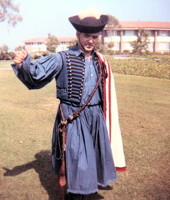
|
Folk Dance Federation of California, South, Inc.
|

|
CLICK IMAGE TO ENLARGE
Dance names, in most cases, are more than just convenient labels or identification tags. They can reveal valuable information, if we know how to interpret them. Dance historians and researchers use the original dance names as important clues in their scientific investigations and analysis. Consequently, even a short study of Hungarian dance names can provide some additional information for those who are engaged in international folk dancing, information which can help and guide even the mildly interested individual through the increasing number of dances and their names.
Most of the popular Hungarian dances, which are known among American recreational folk dancers, have double names: "Palóc csárdás," Kapuvári verbunk," "Somogyi karikázo." etc. One word identifies the dance type, the other is a reference to its geographical or ethnic origin. This dance-naming practice is generally used in Hungary throughout the folk dance movement. Its transplantation for our use provides us with similar practical benefits.
Among the native peasantry the original dance names are generally limited to a one-word reference to identify the type of dance, such as "csárdás," "verbunk," "karikázo," or at most to indicate the tempo of the particular dance, such as "lassú csárdás" or "friss csárdás." This seemingly simple and logical practice becomes somewhat confusing when one finds out that the natives are not always consistent with their name usage. For the same or similar dances sometimes they have different local name variants, or with the same name they cover different types of dances. Only the linguistically and otherwise well-oriented can make sense out of this easily confusing situation. However, in all the scientific and in most of the popular folk dance publications Hungarian authors use an established and consistent terminology.
To indicate the geographical or ethnic origin of a dance is a practice of the "outsiders," who have to deal with dances of many different areas. This kind of reference provides not just the obvious information, but can reveal further clues about a dance. It is becoming generally known that dance types have variations not just in technique, but in style of execution, in formations, in tempo, etc. A geographical reference attached to a single dance name immediately indicates that that particular dance is done within the framework of the so-called "dance dialect" of that region or locality.
In Hungarian dance names the reference of their origin may grouped into different categories: the names of large sections of the country (Dunántúl, Tiszántúl, Alföld, Erdély, etc.), the names of smaller regions (Sárköz, Kiskunság, Rábaköz, Mezőség, etc.), the names of administrative districts (Somogy, Szatmár, Békés, etc.), the names of towns or villages (Kapuvár, Kalocsa, Kevi, Szék, etc.), the names of ethnic groups who live in certain areas (Palóc, Kun, Székely, Csángö, Matyó, etc.).
The geographical references usually end with an "i," which is a noun-suffix meaning "from." For example:
- ECSERI means "from ECSER."
In the American folk dance movement, dance names assume particular significance. For a long period of time a specific name belonged to a specific dance, usually unchanged and without variations, bound and rigidly preserved by standardized descriptions and inflexible practices. In the rapidly changing world the folk dance movement also goes through certain expansion, evolution, progression, and diffusion. Dances and dance names are not "sacred cows" any more. Under the same dance names different teachers, or the very same one, might teach different variations of a dance. Or the same dance can appear under various
Names
It seems that the "uncomplicated" period of International folk dancing, when one name meant one dance, is slowly coming to an end. Undoubtedly dance instructors have to provide more information and explanation about their dances and their naming practices, so that folk dancers can guide themselves through the increasing numbers of new dances and the variety in their names. The following collection of terms is part of the majority of the Hungarian dance names. They refer to the major dance types and to some of their name variations.
- CSÁRDÁS: From the word CSÁRDA (roadside inn). Usually a couple dance with a slow and fast part.
- UGRÓS: From the word UGRIK (jump). Historically an old dance type with many regional variations, different formations, and functions.
- VERBUNK: From the German word WERBEN (recruit). Usually a men's dance in a circle or in solo form.
Other Names
There are many other names used for the same type of dance:
- CINEGE: (titmouse) Group, solo or couple dance of Sárköz region.
- CSILLAGÁNC: (stardance) Like CINEGE, but done by two couples in a hand-star formation.
- DUS: Marching dance of Rábaköz.
- KANÁSZTÁNC: From the word KANÁSZ (swineherder). Closely related to the UGRÓS type of dance. Usually a solo men's dance performed with sticks or axes.
- KARIKÁZÓ: From the word KARIKÁ (ring). A closed circle dance done by girls.
- LEGÉNYES: From the word LEGÉNY (lad or unmarried man). A general name for Transylvanian men's solo dances.
- MARS: Marching dance of Drágszél, Kalocsa.
- OLÁHOS: (Valachian). Solo or couple dance from Southern Hungary.
- PONTOZÓ: From the word PONT (dot, punctuate).
More Common Names
- KÖR: Circle.
- LASSÜ: Slow.
- LEÁNYTÁNC: Women's dance.
- PÁROS: Couples.
- FRISS: Fast.
- SARKANTYU: Spur.
- SŰRŰ TEMPÓ: Fast tempo.
From a 1978 article. Used with permission of the author.